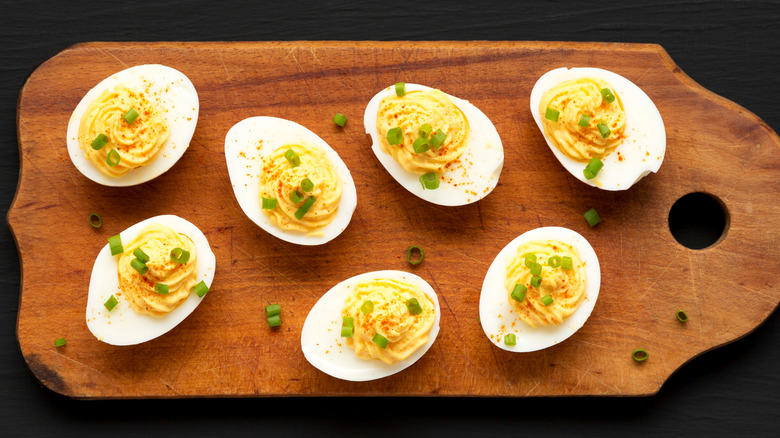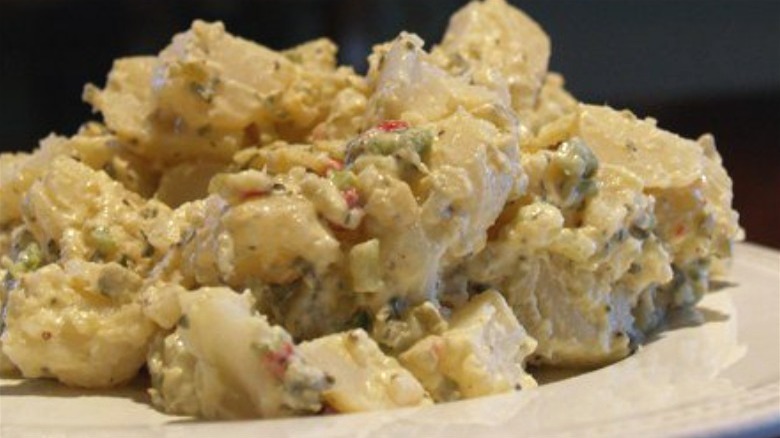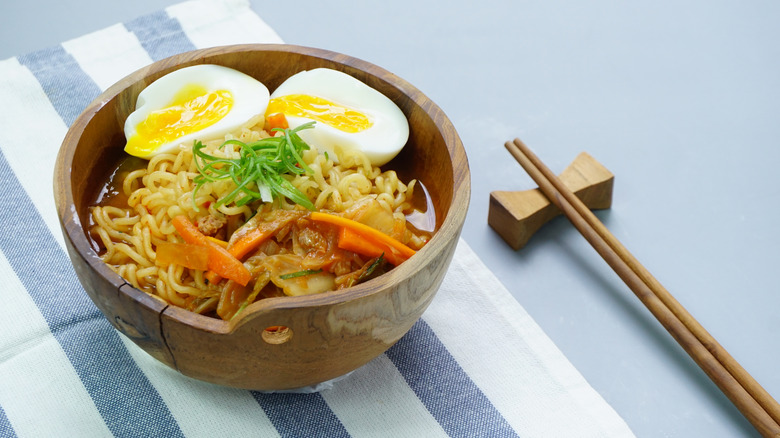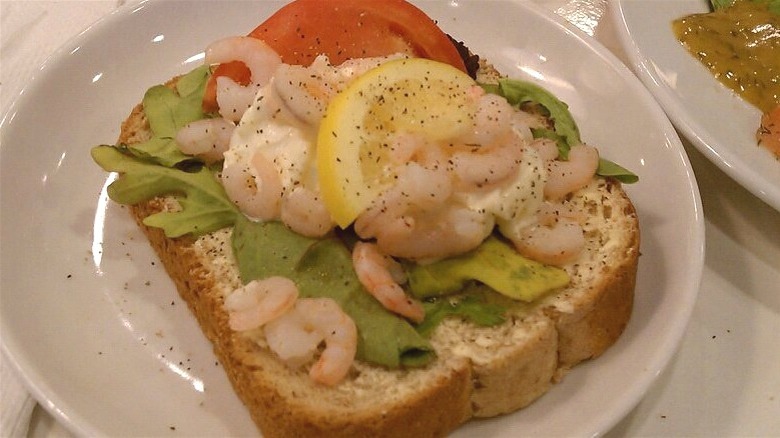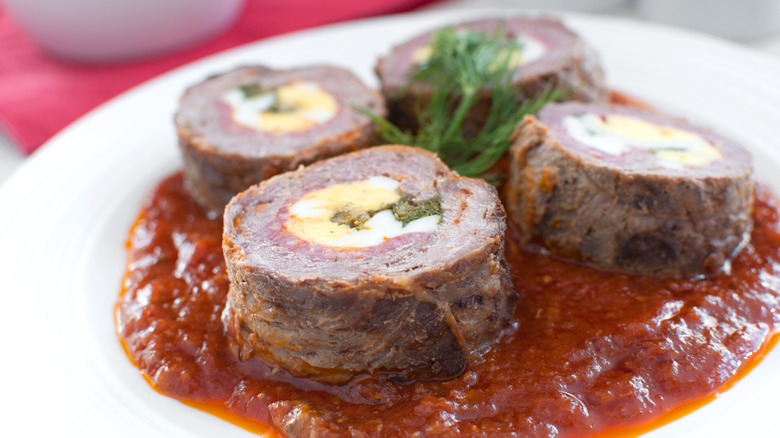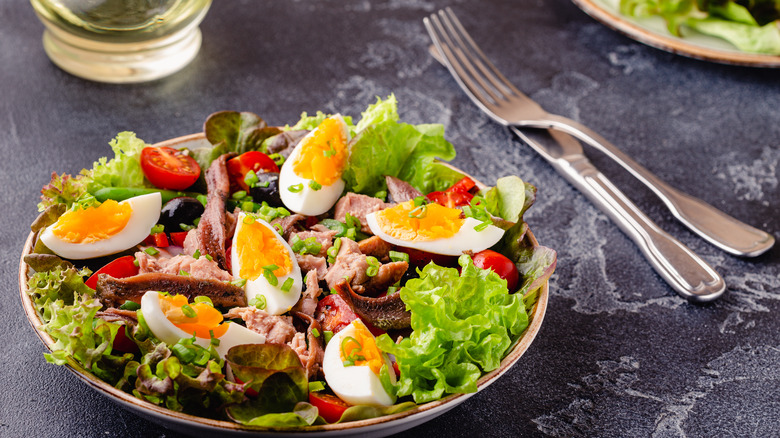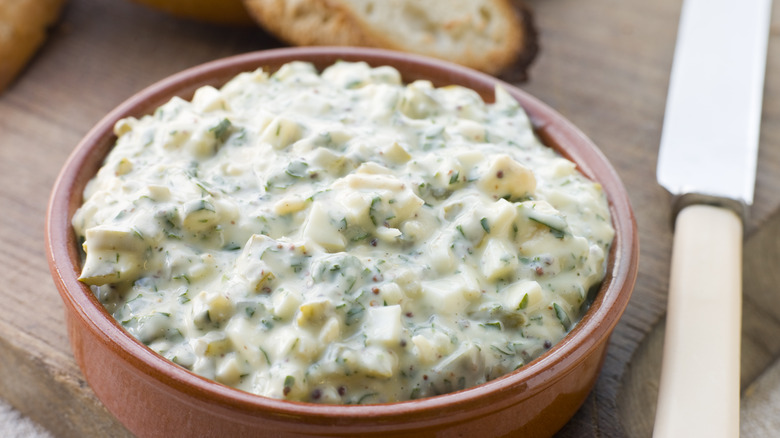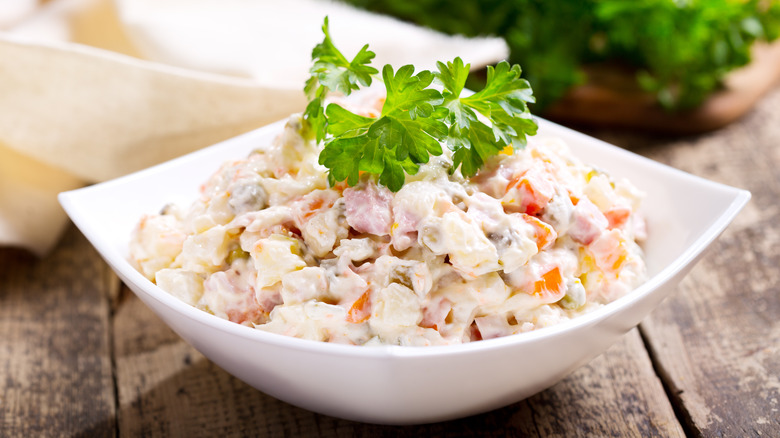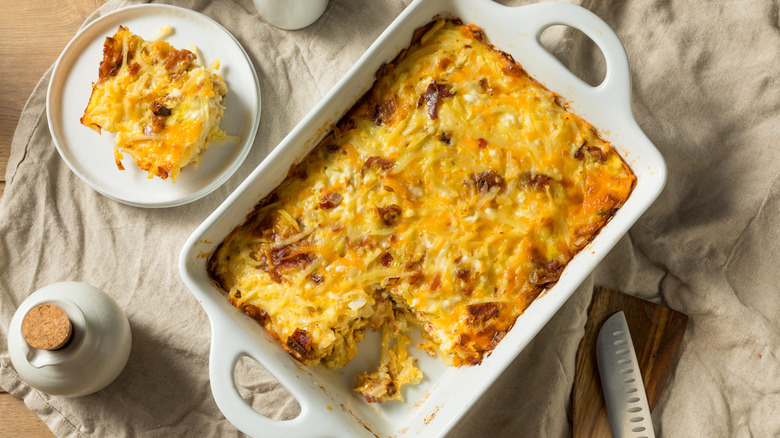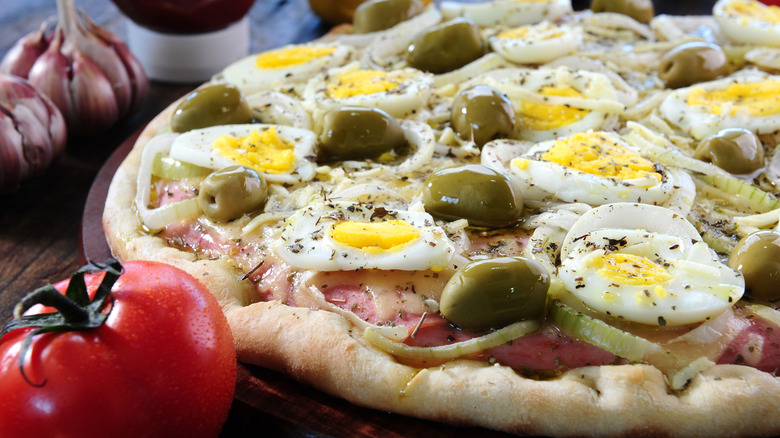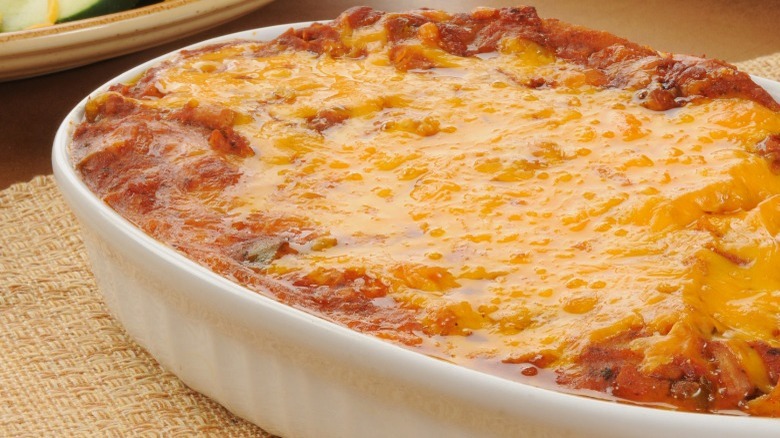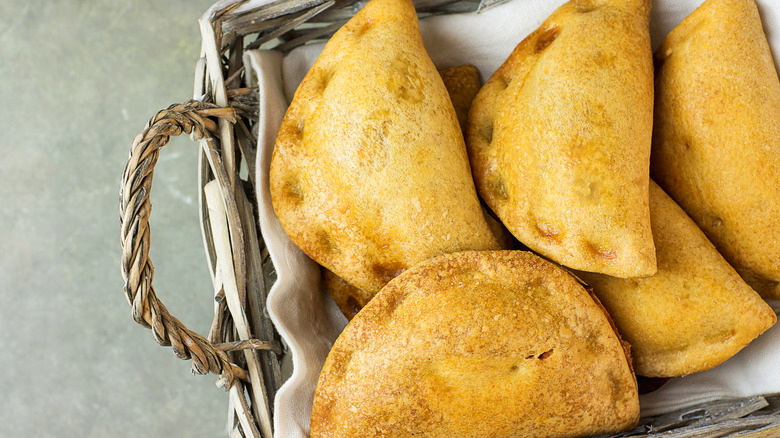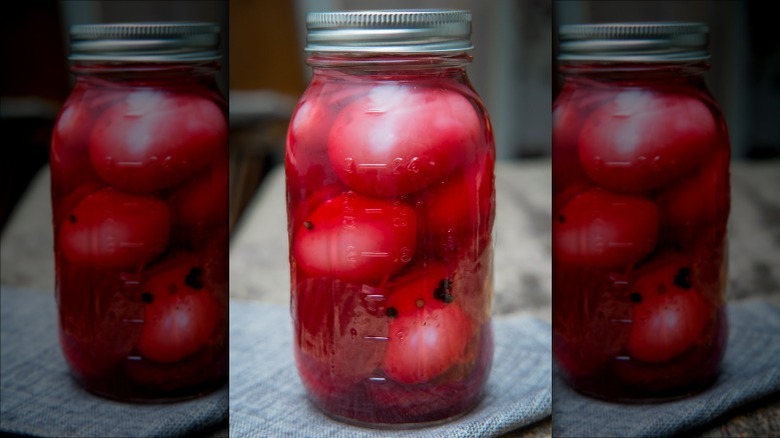Here's What You Can Do With Leftover Hard-Boiled Eggs
Did you go egg-stra crazy with Easter preparations this year? If so, you might be looking at a few cartons of colored eggs you're not sure how to use up. Whatever you do, don't just egg-nore them! The FDA says boiled eggs only last for a week, although the Pioneer Woman website suggests you might be able to keep them for up to 10 days. Still, you'd better make plans for them before that time is up, since letting food go to waste is no yolking matter -– in fact, it's downright in-eggs-cusable.
While hard-boiled eggs are hard to beat (ha!) as a source of protein, they can be a little dull on their own, and after the first few days egg salad sandwiches aren't all they're cracked up to be. If you've eggs-hausted all of your ideas for what to do with your Easter overage, never fear! We're here with a list of egg-cellent ideas to help you out. Also, we promise we're (almost) done with our egg-centric punning. If we crack any more, like the wannabe comedi-hens we are, just feel free to egg-nore them and skip straight to the recipes conveniently outlined in each slide.
Devil them ... with a twist!
Which came first, the chicken nugget or the deviled egg? Duh, the egg, of course! This perennially popular picnic food can trace its roots back to ancient Romans, while extruded poultry products may be a midcentury American invention (via History). Making simple deviled eggs is a fairly straightforward process: Slice hard-boiled eggs in half, scoop out the yolks, mix them with mayo and various seasonings, and then stuff the filling back into the egg whites. What we're offering here is a better mousetrap –- er, recipe hack -– involving a secret ingredient: butter.
If you're making a dozen deviled eggs at a time, you'll need two tablespoons of butter; for half a dozen, use half the butter. If you're deviling a different amount, then you can do the math yourself. Mix the softened butter into the mashed yolks, then add the mayo and any other embellishments you like: mustard, chopped chives or herbs, hot sauce, salt, pepper, etc. If you want to be really fancy, use a piping bag to swirl the yolk mixture back into the whites. You can feel confident in the fact that the butter will help those swirly shapes hold up. If you're more concerned with how the eggs taste than how they look, you can just use a spoon for the filling.
Give your potato salad an upgrade
Potato salad in its simplest form may consist of little more than boiled potatoes and mayo, but that can get a wee bit boring. If you want to jazz it up, as well as give it a little protein to balance out the carbs and fat, hard-boiled eggs make for a great addition.
For each pound of potatoes you're using in your salad, you can add a boiled egg or two. Boil the potatoes and peel them if you like — or leave the skins on and label the salad as rustic. Cool the potatoes and dice them, then chop up the eggs as well. Mix the eggs and potatoes together along with any additional add-ins you like such as chopped celery, pickles, or onions, using mayo to bind everything together. Season with salt, pepper, and maybe some garlic powder, cayenne, or Tabasco sauce. You could even go hog-wild and throw in crumbled bacon for a salty crunch. Once you're done, stick the salad in the fridge for a few hours so all of the flavors can blend into one harmonious whole.
Use them to top a bowl of ramen
One of the easiest and tastiest ways to upgrade a bowl of ramen – whether it be the instant kind or a more elaborate homemade recipe – is to add an egg. Some brave souls simply crack a raw egg into the bowl and let the hot broth poach it to some degree of doneness, while others opt for using soft-boiled eggs. If hard-boiled eggs are what you have on hand, they can work as well.
For a single serving of souped-up ramen (we made no promises regarding non-poultry-related puns), sauté a handful of veggies such as onions, mushrooms, bamboo shoots, and anything else you like. Throw in a little bit of minced garlic and grated ginger and cook everything for about 30 seconds. Boil the noodles in the broth according to the package directions, then stir in the vegetables along with the seasoning packet. Peel and slice an egg and toss it in there, too, then season your ramen with soy sauce, sriracha, sesame oil, or whatever fixings strike your fancy.
Recreate this IKEA open-face sandwich
For many of us, IKEA is primarily a restaurant that just happens to have a weird furniture-selling theme going on, like a more elaborate version of the assorted tchotchkes you can buy at Cracker Barrel. While IKEA is justly famed for its meatballs, other popular menu items include bargain-priced hot dogs and a fudgy chocolate cake. Among our favorite IKEA eats, however, are the open-faced sandwiches known as smørrebrød –- particularly the super-tasty egg-and-shrimp combos.
To make a sandwich similar to IKEA's, toast a slice of bread -– rye, wheat, or white will all work. Lightly butter the toast, then top it with lettuce and a sliced-up boiled egg. Arrange some cooked shrimp on top of the eggs, then dress them with a mixture of sour cream and mayonnaise. Add some snipped chives, fresh dill if you like, and a few paper-thin slices of lemon.
Make a Sicilian-style braciole
Braciole, a dish with Sicilian roots, is typically made with a large, thin slice of beef that is stuffed, rolled, and sliced to make what appears to be a meat pinwheel. The ingredients used to stuff the meat vary widely from recipe to recipe and include cheeses of various types, breadcrumbs, spinach, and pine nuts. Martha Stewart even makes a version stuffed with olives and raisins, but our favorite style of braciole (sorry, Martha!) is the kind that's stuffed with salami and hard-boiled eggs.
To make braciole, start with a thin, flat cut of meat such as a flank steak. If you need to, you can pound on the meat with a mallet to make it even thinner to help it contain all of the stuffing. Layer the meat with goodies like slices of provolone or mozzarella, salami, and prosciutto, then chop up a few boiled eggs and sprinkle those over the top. Add some grated Parmesan cheese as well as chopped garlic and parsley, then roll up your braciole using toothpicks to help it stay in place. Brown the meat on all sides in a skillet using a little olive oil so it doesn't stick, then simmer it in marinara sauce for a few hours until it's tender.
Use them in a classic salade Niçoise
Salade Niçoise, as its name implies, is a salad thought to have originated in the French city of Nice located on the postcard-perfect Côte d'Azur. While you may not be able to afford a vacation on the French Riviera, you can eat as if you were gazing out upon the Mediterranean Sea ... and yes, this salad fits nicely into a Mediterranean diet. While people tend to disagree about what ingredients belong in a Niçoise salad, generally most recognize that hard-boiled eggs are an indispensable part of the dish.
Julia Child was the one who introduced salade Niçoise to most American cooks, but her version is fairly complex and calls for both anchovies and capers. For a simpler Niçoise, boil a few potatoes and chop them up into bite-sized chunks. Arrange them on a bed of lettuce along with some peeled and quartered boiled eggs, cherry tomatoes, cooked green beans (preferably not the canned kind), olives, and a can of tuna. Top the salad with a vinaigrette dressing or a mixture of freshly squeezed lemon juice and olive oil.
Or in a sauce gribiche
If you're a big fan of "Chopped," then you may recall a bearded guy named Gavin Jobe who won big back in 2017. If you also have the memory of an elephant, you might even remember one of the dishes that helped take him over the top – a sauce gribiche that he prepared using "Alton's magnificent smoked meatballs," as well as cardoons, shishito peppers, and smoked hard-boiled eggs. Well, that certainly sounds ... interesting, but it's hardly a typical gribiche. Despite the meatball suck-up, even Alton Brown wasn't a fan of Jobe's version.
A simpler gribiche, however, is a great way to use up your boiled eggs. It can be described as a salad dressing-egg salad hybrid that's typically made with olive oil, white wine vinegar, some type of fancy mustard (whole grain or Dijon would be good, but French's yellow is right out), capers, chopped parsley or other green herbs, chopped cornichons, and a couple of hard-boiled eggs. The ingredients are all mixed together, then used as a sauce to top cooked vegetables or grilled fish.
Make this Russian holiday dish
No Russian or Ukrainian New Year's celebration would be complete without Olivier salad, a dish that was invented by the 19th-century French chef whose name it bears, per Russia Beyond. Lucien Olivier was running a restaurant in Moscow at the time, and he created this dish with Russian palates in mind. He certainly succeeded in doing so, as this salad is now considered a staple of the winter holidays. While the original recipe may have been made with grouse and crayfish, nowadays these have been replaced with more readily obtainable and affordable options such as sausage, chicken, or ham.
To make an Olivier salad, peel and roughly chop a few boiled eggs, then mix them with your cooked meat of choice. Add some green peas (frozen ones work fine, and there's no need to thaw them), chopped boiled carrots and potatoes, green onions, and chopped dill pickles. Bind the salad with mayonnaise, then season it with salt and pepper. If you want to double down on the dill, you can add it as a fresh herb as well.
Turn them into a low-carb breakfast casserole
Breakfast casseroles aren't as quick and easy as they're cracked up to be (sorry!), but they do allow you to get most of the prep work for a big morning meal out of the way the night before. Many such casseroles are made with bread soaked in an egg and milk mixture, but for a lower carb version you can build one around hard-boiled eggs in cheese sauce.
Slice your eggs, then fry and chop some breakfast meat: bacon, sausage, or ham all work here. You can use store-bought queso or condensed cheese soup for the sauce, or else you can make a simple white sauce (look on your cornstarch box for a recipe) and stir in a few handfuls of shredded cheddar or other semi-soft cheese. Pour some of the sauce into a casserole dish or baking pan, then add a layer of eggs, a layer of meat, and more cheese sauce. Repeat until you've used up all the ingredients, finishing off with a top layer of sauce and a generous sprinkling of grated cheese. You can bake it right away, although it won't be harmed by a night in the fridge, either. When you want to serve this casserole, bake it at 350 F for about 20 minutes or so until it's hot and bubbly.
Make a Brazilian-style pizza
While pizza as we know it was probably invented in Italy and brought to our shores by Italian immigrants, the U.S. doesn't have a monopoly on immigration. As it so happens, the country of Brazil has a fairly sizable Italian-Brazilian population (per Statista), and they've evolved their own unique style of pizza that differs in many ways from its North American counterpart. Among the types popular in Brazil is one called atum, which features tuna and onions; another called brócolis with broccoli, bacon, and cream cheese; and a pizza known as Portuguesa which features fresh tomatoes, sausage, ham, onions, peppers, olives, and hard-boiled eggs.
Since we're talking about using up eggs, the Portuguesa pizza is going to be the one of most interest. To make it you'll start off as usual: crust, tomato sauce, mozzarella. Once you've topped the crust with sauce and cheese, layer on some smoked ham, sliced Spanish-style chorizo (this is the kind that resembles pepperoni rather than the loose Mexican style of sausage), sliced fresh tomatoes, sliced yellow onions, chopped green pepper, and whole (but pitted) black or green olives. Season the pizza with oregano and some crushed red pepper if you like it spicy. Bake the pizza until it's done, then top it with sliced boiled eggs.
Cook them in a spicy tomato sauce
Eggs in tomato sauce have been having a moment lately, particularly Middle Eastern shakshuka but also other international variants including Latin American huevos a la cazuela and Italian uova piccante in purgatorio (known in English as eggs in purgatory or eggs in hell). While these dishes typically involve poaching raw eggs in a spicy sauce, you can give the same treatment to hard-boiled eggs.
Start by peeling and halving your boiled egg, then top them with a marinara sauce spiced up with crushed red pepper or perhaps a chopped jalapeño or two. If you have no marinara on hand, you can also make a super-quick sauce by pureeing a can of diced tomatoes with green chiles. Cover the sauce with grated cheddar, provolone, pepper jack, or Parmesan, or use crumbled feta or cotija. Bake the eggs in the sauce for about 15 to 20 minutes at 350 F until the cheese has melted and the sauce is heated through.
Make Argentinian or Chilean-style empanadas
Empanadas are a food that is popular throughout Latin America, and each country has its own particular preferences with regards to cooking styles, dough, and fillings (via Remezcla). In El Salvador, Nicaragua, and Costa Rica they like to stuff their empanadas with plantains, while Ecuador goes with a sweet-savory combo: fried cheese inside and sugar outside. In Chile and Argentina, however, empanada fillings often include hard-boiled eggs.
While making empanadas from scratch can be pretty time consuming, we're all for time-saving hacks like using frozen puff pastry or pie dough. For the filling, you'll need to brown ground beef and sauté onions, then mix the two and stir in some raisins and sliced olives (black or green, your choice) along with a pinch or two of salt and pepper. Roughly chop a few boiled eggs and gently fold them into the mixture. Cut out large circles of pastry, pile on a few spoonfuls of filling, then fold the dough over to make half-moons and pinch the edges to seal them. Bake the empanadas at the temperature recommended on the pastry package until they're a nice golden brown.
Pickle them
Pickled eggs come across as some kind of movie prop since every set portraying a stereotypical dive bar seems to feature a gallon-size jar of eggs floating in pink liquid that no one ever touches. If you've ever actually frequented an IRL bar selling these eggs (surely they're not just a cinematic trope?) and you've been brave (or spirited) enough to order one, you were probably pleasantly surprised. Pickled eggs might look a bit weird, but they're actually quite tasty!
More to the point here, pickled eggs are a super easy way to not only use up your hard-boiled eggs but to preserve them so they'll last until you regain your appetite for them. To make pickled eggs that are pretty in pink you'll need a can of beets. Put the beets, liquid and all, in a jar, then fill the jar with peeled hard-boiled eggs. Add a 50/50 mixture of white vinegar and water to fill the jar to the top. You can also add some sugar, salt, and pickling spices if you wish. The eggs will need a few days to pickle but they should last for a month or more in the fridge.
Use them to make ... cookies (no really, they're good!)
While every single dish we've covered so far has been savory, it is possible to incorporate boiled eggs into a dessert recipe. While this may sound egg-centric (oops! it just slipped out), Bon Appétit assures us that using hard-boiled eggs in baked goods has been done by bakers in Northern Europe for years. Actually, if you think about it, it's not that weird. Most cookie recipes contain eggs, so what's the big deal if those eggs are cooked before they go into the dough? With that in mind, we present: hard-boiled egg chocolate chip cookies!
If you're using the yolks alone, you can stir a yolk or two into any cookie recipe and it will help keep the dough from becoming too tough. You can also experiment with using cooked eggs in place of raw ones by starting with a very forgiving recipe like one for chocolate chip cookies. Omit the raw egg and replace it with two finely chopped boiled eggs. Be sure not to over-bake the cookies, as the dough is less moist than when using raw eggs, and you risk drying out the final product if it's cooked too long.

